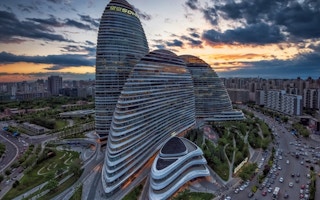China’s green building industry is exploding, with green space growing 154 times since 2008 and taking the lead from the US in terms of gross floor area, according to a new research report from global real estate services company CBRE.
The New Era of Green Buildings in China found that as of January 2015, China had 2538 projects with the country’s Green Building Evaluation Standard certification, representing gross floor area of 290 million square metres, as well as 627 LEED projects as of April 2015, adding an additional 28 million sq m.
“Adding the green building stock certified under the China Green Standard and LEED together, China already has 3165 certified green buildings, amounting to a total GFA of 320 million sq m, slightly higher than the 310 million sq m of certified LEED GFA in the US,” the report said.
While China had begun relatively late in the green building space, the report said the size of the Chinese construction industry (the largest in the world) meant there was significant room for growth. With increasing concern over environmental issues a strong pressure point, and a government commitment to reform the economy, further strong green building action is expected.
“CBRE estimates that in the period between 2014-2020, the total new construction of urban green buildings is expected to reach seven billion sq m,” the report said. “This massive boom in the construction of green buildings will usher in unprecedented opportunities for development.”
CBRE said the growth in green buildings in China would have five key features:
- proliferation from developed regions to the whole country – currently more than 80 per cent of domestic green construction projects are located in the top 10 provinces in terms of GDP
- proliferation from residential to commercial buildings – Commercial green building area currently accounts for less than 30 per cent of total green building area
- starting from new buildings to cover existing buildings gradually – of the 40 billion sq m of existing building stock in China, 99 per cent do not have green building certification
- from “green marketing” to “full life cycle” – Between 2008 and 2014 more than 90 per cent of China Green Standard certified projects were certified on only design
- further evolving of green building policies and standards – China’s green building policies and standards will continue to move towards covering buildings’ full life cycle
Green building is cost-effective
The report found the cost of building green in China was not prohibitive – 0.8-6.1 per cent of total construction costs – with a considerable portion able to be covered by government subsidies.
“The incremental cost mainly covers the following seven aspects: exterior decoration, building envelope system optimisation, recyclable energy utilisation, cool and thermal storage technology, non-traditional water resource utilisation, interior environment control and intelligent systems,” the report said.
“CBRE believes the incremental cost of green buildings will decrease in the coming years, primarily because of the rapid development of green technology, products and process technique, and the selection of more effective green building features by developers with the help of professional consultants. Market demand and supportive government measures will make investing in green buildings an attractive proposition.”
CBRE also found evidence of increased occupancy and rental and capital value performance from green buildings, with LEED-certified Grade A buildings commanding a rental premium of between 1.5 per cent and 25.7 per cent compared with non-LEED buildings.
“In addition, LEED certified projects were found to be more resilient in weaker markets where rents are decreasing and vacancy is higher, a trend observed in Beijing, Shanghai, Guangzhou and Chengdu.”
Aside from the higher rental incomes and the operational cost savings of green buildings, government subsidies and preferential tax policies were an important component of green building investment returns.
“In China, government at different levels has introduced a number of fiscal preferential policies and subsidies to promote the development of green buildings,” the report said.
This includes two and three-star rated buildings getting subsidies of RMB45 and RMB80 a sq m, respectively.
Differences between the China Green Building Evaluation Standards and LEED
The report detailed the differences between the country’s two major rating systems, finding:
- LEED had a high rate of voluntary market adoption while the China Green Standard relied more on government enforcement
- LEED had a strong focus on certifying the full life cycle of buildings, while the China Green Standard neglected operational elements of buildings
- LEED had more sub-categories but the China Green Standard was improving
- LEED placed greater emphasis on energy-saving and emission-reduction, while the China Green Standard was more balanced
Read the full report.

















